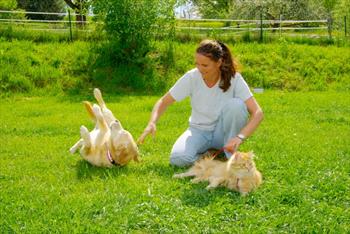Woman playing outside with dog and cat

Photo courtesy of Depositphotos
I’ve had a blog writing dry spell lately (too much other stuff to catch up on), so I’ll jump back with a quick summary of some recent papers on SARS-CoV-2 in animals. There isn’t really anything surprising here, but it’s a continuation of what we’ve been learning and saying for a while.
SARS-CoV-2 infection in cats and dogs on affected mink farms, the Netherlands
We have various concerns related to SARS-CoV-2 outbreaks on mink farms. One is the potential for spread to other animal species, with further risk of transmission, the potential evolution of virus mutants, and possible establishment of a virus reservoir, especially among wildlife.
This study tested a few different groups of companion animals, including 44 stray cats on infected mink farms. Ten of the cats had SARS-CoV-2 antibodies (seropositive), indicating previous infection. The single dog that was tested was also seropositive. This is consistent with other data that the virus can spread beyond mink on infected farms. The risk that poses for further transmission back to people or to other animals is unclear, but it’s a reminder of why we really need to keep this virus out of large susceptible animal populations like mink.
They also tested 500 feline and 500 canine serum samples that were submitted to their diagnostic lab for routine testing. Two cats (0.4%) and 1 dog (0.2%) were positive for antibodies. Since we don’t know anything about whether those pets were exposed to anyone with COVID-19, it’s hard to put those results into perspective.
SARS-CoV-2 in pets from COVID-19+ households in Utah and Wisconsin
This pre-print describes a study involving 37 dogs and 19 cats from 41 households where a person had COVID-19.
- No active infections were identified in the pets by PCR.
- Four cats and 4 dogs had antibodies to SARS-CoV-2, indicating they had been infected. That’s consistent with our ongoing surveillance, in that it’s easy to miss the active infection based on timing of sampling but previous infection can be detect retrospectively based on antibodies.
- They also reported that of 14 pets that had limited contact with infected people after the person’s diagnosis, none of them became seropositive, compared to 4 of 19 (21%) pets that had ongoing contact with an infected person. That’s not surprising, and supports our messaging to limit contact with animals as much as possible when COVID-19 is suspected in a person.
Role of SARS-CoV-2 infection in pets with severe disease
It has been a challenge in a small number of cases to figure out if an animal got very sick or died from SARS-CoV-2 infection, or whether infection was just incidental. A pre-print from the U,S. CDC describes an investigation of 5 cats and 5 dogs that died while they were infected with the virus.
- In one cat with severe respiratory disease, examination of the cat’s tissues and lack of other potential causes of illness suggested that SARS-CoV-2 was the primary cause of disease and ultimately euthanasia.
- In one dog, it was suspected that SARS-CoV-2 infection exacerbated the animal’s underlying severe and chronic respiratory disease and likely contributed to its illness.
So, in those two cases, SARS-CoV-2 likely caused or contributed to the animal’s death.
- In the other 8, infection was deemed incidental (although in a couple of the cases, I think an argument could be made that infection may have worsened an underlying problem – it’s hard to say).
This information is consistent with what we’ve already been saying: Infection of cats and dogs isn’t rare, but severe disease is. It’s possible, but not a common outcome.
More on infection and heart disease in cats
I wrote earlier about how we need to be careful interpreting a pre-print suggesting the B.1.1.7 SARS-CoV-2 variant was linked to myocarditis in cats. This new pre-print describes a single case report of hypertrophic cardiomyopathy (HCM) in an infected cat. Note that HCM is not uncommon in cats.
- A person in the household was diagnosed with COVID-19 about a week before the cat got sick.
- The cat was euthanized and testing identified a thickened heart muscle, consistent with HCM.
- SARS-CoV-2 virus was detected in various tissue samples, including the heart. That supports that the cat was truly infected at the time of death.
- There were clear signs of respiratory infection, which isn’t surprising since SARS-CoV-2 is a respiratory virus. Whether that means it caused heart disease or exacerbated it is the bigger question.
- There was evidence of inflammation in the heart tissue, which raises concern that the virus was at least contributing to the heart disease.
Overall, it’s quite possible that SARS-CoV-2 infection exacerbated this cat’s underlying heart disease to the point that it required euthanasia. That would be consistent with the pre-print described above about rare cases of severe disease in already-compromised dogs and cats. It’s relevant because it shows that while most of the time infection is mild or inapparent, severe disease can happen, and it’s probably more likely to occur in dogs and cats with pre-existing heart or lung disease. People shouldn’t get too worried because we’ve probably had hundreds of thousands of infected pets (or more, since we’ve had millions of infected people) and only very rare reports of severe outcomes.
Reprinted with permission from Worms and Germs Blog